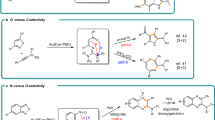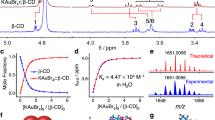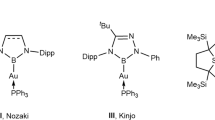Abstract
TERVALENT gold is usually four-covalent in its compounds and possesses a square-planar arrangement associated with 5d6s6p 2 bonding1. Complexes of gold(III) with a co-ordination number greater than four have recently been prepared by Harris and Nyholm2. These compounds are of the types [Au(diarsine)2 X](ClO4)2 and [Au(diarsine)2 X 2]ClO4 (where X = Br or I and diarsine = o-phenylenebis-(dimethylarsine)). Bivalent palladium and platinum, which possess a similar d 8 electronic configuration, also exhibit co-ordination numbers greater than four with this ligand3,4.
This is a preview of subscription content, access via your institution
Access options
Subscribe to this journal
Receive 51 print issues and online access
$199.00 per year
only $3.90 per issue
Buy this article
- Purchase on SpringerLink
- Instant access to full article PDF
Prices may be subject to local taxes which are calculated during checkout
Similar content being viewed by others
References
Pauling, L., “Nature of the Chemical Bond”, 100 (Cornell Univ. Press, 1948).
Harris, C. M., and Nyholm, R. S., J. Chem. Soc., 63 (1957).
Harris, C. M., and Nyholm, R. S., J. Chem. Soc., 4375 (1956).
Harris, C. M., Nyholm, R. S., and Stephenson, N. C., Nature, 177, 1127 (1956).
Harris, C. M., Livingstone, S. E., and Reece, I. H., Aust. J. Chem., 10, 282 (1957).
Bjerrum, N., and Kirschner, A., Kgl. Danske Videnskabernes Selskab, 8, No. 1, 76 (1918).
Elliot, N., and Pauling, L., J. Amer. Chem. Soc., 60, 1846 (1938).
Author information
Authors and Affiliations
Rights and permissions
About this article
Cite this article
HARRIS, C., REECE, I. Formation of Higher Bromo-Complexes of Tervalent Gold in Non-Aqueous Solution. Nature 182, 1665 (1958). https://doi.org/10.1038/1821665a0
Issue date:
DOI: https://doi.org/10.1038/1821665a0



